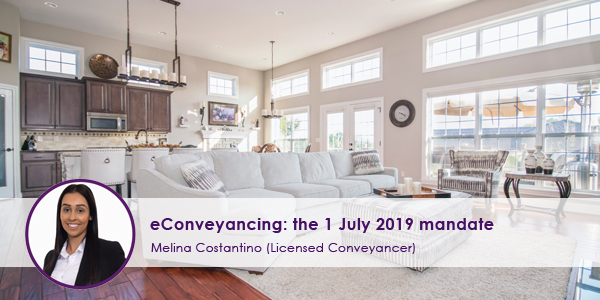Conveyancing is the legal process involved in buying or selling property. eConveyancing is the same process but completed electronically meaning the paperwork involved in a manual conveyance is substantially reduced. The transition to eConveyancing aims to transform NSW into the most efficient and secure place to buy and sell property.
eConveyancing has been a long time coming and from 1 July 2019, mainstream property dealings can no longer be lodged in paper in NSW. This includes transfers, mortgages, discharge of mortgages, caveats, withdrawal of caveats and transmission applications.
Currently in NSW, over 85% of eligible conveyancing transactions are being completed electronically. This percentage is only set to increase as we reach the 1 July mandate.
So, how will this benefit you? So glad you asked.
You get your money faster. Funds are paid and cleared in your account instantly, on the day of settlement. There is no more waiting for cheques to be banked and for funds to then clear. With eConveyancing you have immediate access to funds from settlement.
Reduces costs. Some banks charge $10, even $15 per bank cheque required for settlement. With e-Conveyancing, funds are paid electronically, eliminating the need for bank cheques and additional expenses like bank cheque fees.
Safety first. e-Conveyancing is tightly regulated. Processes are in place to verify the identity of the parties and allow parties to electronically sign documents securely. For all those tech savvy people, the data is encrypted and the receiving computer checks the data to make sure it wasn’t changed in transit.
Less risk and more certainty. I was reading something not to long ago that reported 1 in 5 people surveyed experience delays to settlement. Delays to settlement can mean additional expenses and make for a stressful situation. With eConveyancing the risk of errors and delays is significantly reduced, giving you added certainty of a successful on-time settlement. This is achieved through electronic signing as well as better checks and balances through electronic channels. For example, there are no cheques drawn in eConveyancing, the funds are electronic. This eliminates the chances of cheques being drawn incorrectly resulting in a delay or even a cancellation to settlement.
Less paperwork. Sending documents in the post to be signed increases the risk of delays to settlement, particularly when documents are lost. With electronic signing, there are far less, if any, documents being posted.
Saves time. In order for settlement to occur, the Transfer must be signed. Electronic signing means you can avoid the hassle of printing, scanning and posting documents. You don’t need to make time to drop into the office to sign documents either. The Transfer is signed by your Solicitor or Conveyancer on your behalf, using their digital certificate.
Peace of mind. In the manual world documents required to transfer ownership to you are typically not lodged for days or sometimes weeks after settlement. With e-Conveyancing it is instant, giving you peace of mind. The change of ownership occurs on the day of settlement, with electronic lodgement to Land Registry Services. This also means Government authorities like Council and Water are advised of the change of ownership much sooner.
Moving forward, in order to complete your property transaction it is important that you ensure your Solicitor or Conveyancer is registered for eConveyancing.
At Coutts Lawyers & Conveyancers not only are we registered for eConveyancing as a firm, but each member of our property law team has undergone extensive training and are certified with PEXA (Property Exchange Australia).
For further information please don’t hesitate to contact:
Melina Maiolo
Licensed Conveyancer
melina@couttslegal.com.au
02 4607 2104
This blog is merely general and non specific information on the subject matter and is not and should not be considered or relied on as legal advice. Coutts is not responsible for any cost, expense, loss or liability whatsoever in relation to this blog, including all or any reliance on this blog or use or application of this blog by you.



